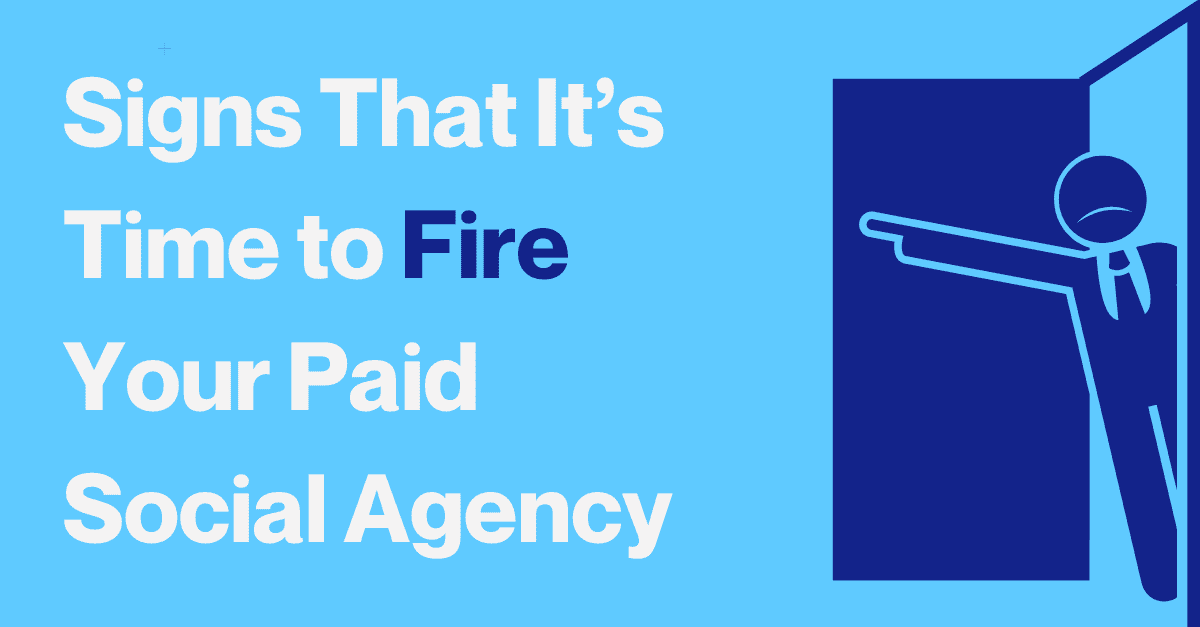A strong paid social marketing relationship requires mutual understanding and effort. Your brand has to be clear about its goals, open to suggestions, and responsive when your marketing partners ask important questions. But on the other side, the agency you’re working with needs to hold up their end of the bargain with innovative ideas, strong reporting, consistent communication, and continual improvement.
At ADM, we frequently speak with companies that are underwhelmed by their paid social media agencies. Here are some of the most common complaints we tend to hear when speaking with or auditing companies:
- “Our agency isn’t producing the results we need to grow”
- “Our paid social media performance isn’t improving month over month, quarter over quarter, or even year over year”
- “It feels like we’re leaving money on the table.”
- “We think we might be wasting money on fruitless ideas.”
- “Our marketing agency doesn’t seem to listen to us when we voice frustration, or doesn’t seem to take our suggestions seriously.”
- “Our marketing partner seems to only act reactively rather than proactively.”
- “No one wants to take accountability for poor performance, and they often blame the marketing technology itself rather than seeking workarounds or better methods.”
- “We end up bringing the ideas to our marketing partner and are looking for a partner that will bring innovative ideas to us”
Deciding when to break off a partnership and move in a new direction can be tricky. If you’ve found yourself expressing any of the sentiments listed out above, however, that might mean it’s time to fire your paid social agency. In this blog, we’ll break down many of the points at which agency-client relationships can fall apart, and what they should tell you about your social media marketing plans moving forward.
The primary pain points in paid social agency-client relationships
When brands begin feeling frustration with their existing marketing partners, they typically originate from one of three key pillars in the relationship—all of which feed into each other:
- Performance: Poor results are the #1 reason we hear from clients who have recently switched or are planning to switch agencies. Typically, there’s a sense that spend is being wasted or good opportunities aren’t being pursued.
- Communication: Poor agency communication also includes slow response times, inability to get in contact with the agency when something time-sensitive arises, and a lack of understanding about how your ads are performing at the most critical times. Sometimes, you’ll notice that performance is down, but no one in your marketing agency can clearly express why, and they seem unwilling to address the topic until they’re forced to.
- Ownership: When results seem inadequate and the agency is hesitant to discuss them, they’ll often blame external factors, like market forces or platform limitations, in ways that are unconvincing or misleading. In other cases, they’ll fail to bring innovative ideas to the table that will help you continue to grow your marketing efforts, instead hoping that they can sit back on what they’ve already done.
Strategic social marketing shortcomings that produce poor performance
You know the performance targets you’ve set—but let’s assess some of the reasons why your account might be falling short. Every paid social media agency has different approaches. At ADM we audit and inherit a lot of other agency accounts, however, and we find a lot of common problems when clients are coming from agencies that were delivering suboptimal performance. Those common problems include:
Mislabeling
A well-labeled account structure is essential for accurate reporting and optimization. It is very common for campaigns, ad sets, and ads to either not be labeled properly or to be mislabeled by prior agencies. A common sign of this is that, when you duplicate an ad, Meta ads will tack on “- copy” to the end of it. A lazy agency will leave that in there, showing a lack of attention to detail or care for the nuances of your strategy. Labeling problems can also extend to creative not being labeled by their medium (image, video, carousel)—a carefully-built account will make the purpose of each ad and creative element clear.
High Audience Overlap
Audience overlap can equal oversaturation and wasted spend. You’ll see this in action if your agency forgets to exclude retargeting audiences from what is labeled as “prospecting” while also running retargeting campaigns. Other common indicators are multiple prospecting audiences that overlap, meaning your budget will be competing against itself.
Over-Segmentation
Segmentation is important and hyper-segmented campaigns used to be best practices on Meta ads. That has changed significantly over the past few years, however: the best practice is now to target broad and let your creative find the audience. If you look at your account and see a number of ineffectual campaigns with very specific audiences, that’s a strong indicator that your current social media agency is stuck in the past.
Lack of creative testing
As mentioned above, creative is more important in paid social media than it has ever been—which means you need to be testing frequently to validate which creative is most impactful. If your agency engages in very minimal or no creative testing at all, that is an indicator your current agency is ignoring the opportunity to learn and improve results. The worst-case scenario of this is when you see ad sets that contain only one live ad.
Tracking Issues:
Optimization needs to be constant, but changes are only as effective as your agency’s data is accurate. If your agency hasn’t carefully validated the events that it bases its strategy and reporting off of, that could spell trouble. For instance, it isn’t uncommon for poor implementation to cause purchase events to double-fire, resulting in misinformation about your Meta campaign’s actual performance
Communication issues that can sink a paid social marketing relationship
Communication is a two-way street, and if you and your social media agency partner aren’t hearing what the other side is saying, the relationship is doomed to fail. The telltale signs of bad communication in an agency partnership are:
Lack of responsiveness:
This is relatively straightforward—you ask a question or lobby a concern and your agency partner doesn’t address it in a timely fashion. Even if your typical point of contact at the agency is out of office and unable to respond, they should have a plan for someone at their agency top have the knowledge of your account and get back to you in the meantime. This is especially important during key times of the year, like Black Friday and Cyber Monday.
Confusing communication/lack of transparency:
Paid social media marketing is highly technical, but your agency partner needs to be able to reach you where you are when discussing your account. Whether intentionally (to obscure poor performance) or unintentionally, agencies can sometimes spend too much time communicating the technical, in-the-weeds work being done rather than focusing on the bigger picture large impact changes happening in the account. If your agency can’t convey technical details in language your team understands, then you’ll never be on the same page.
Reactive vs. proactive communication
A poor agency lacks urgency: they let performance breakdowns slide and hope you don’t notice, only moving a muscle to fix the issues once you bring them to their door. Instead, a good agency will do the opposite, even when it’s inconvenient for them. An expert agency will be proactive in informing you if results are about to come in below expectations, and they’ll have sound reasoning as to why. They’ll also frequently identify new opportunities and ideas to suggest without having to be prompted to innovate.
Good paid social media agencies take ownership and pursue innovation
When assessing your relationship with your marketing agency, consider whether you encounter any of the issues laid out in this blog—and recognize that it doesn’t have to be that way. The right agency partner will always be above-the-board about where your account stands, and they won’t need weeks to respond to simple queries about performance. They’ll also go above and beyond to bring you new ideas for expansion or improved efficiency.
Taking ownership also means staying ahead-of-the-curve. Social media marketing evolves constantly, with new tools being introduced every quarter and new trends constantly changing what content that users respond to. It’s best to find a paid social agency that eagerly integrates the latest features and stays on the pulse of social interaction, rather than falling back into the same methodology they’ve used for years across all their client accounts.
If you’re thinking it’s time to fire your paid social agency, don’t hesitate to reach out to the team here at ADM. We prioritize transparency, communication, and strategies built around each business’s unique goals. Our team can perform a comprehensive social media audit of your current approach to see where opportunities are being missed or money is being wasted, so you can feel comfortable knowing that you’ve made the right decision.




